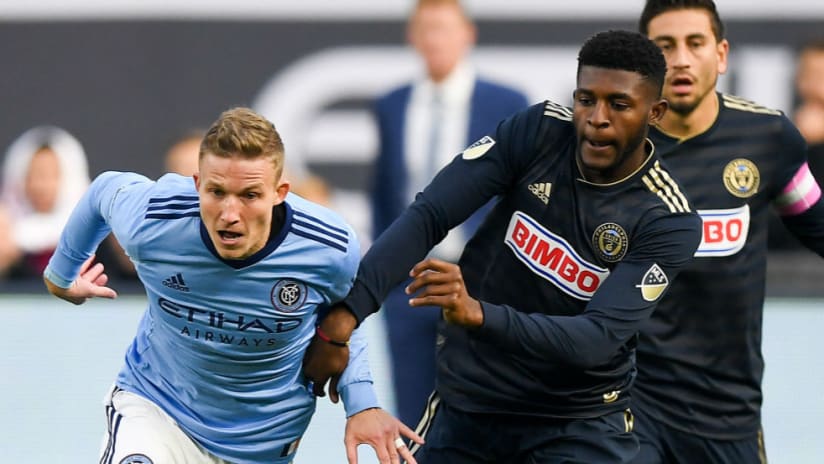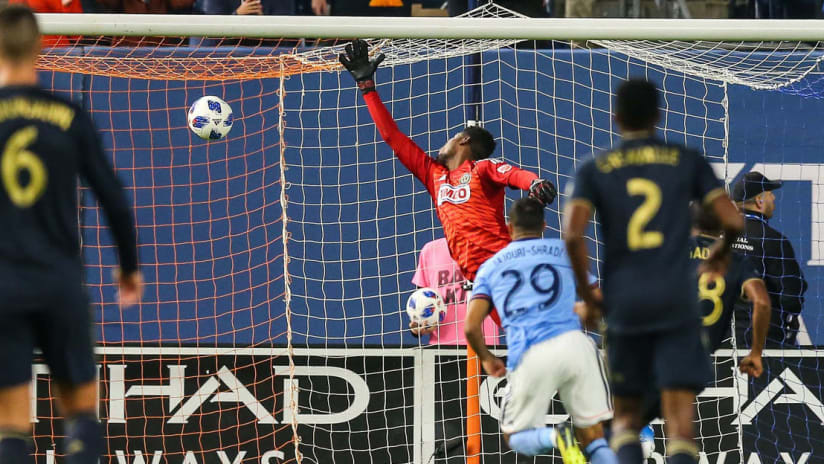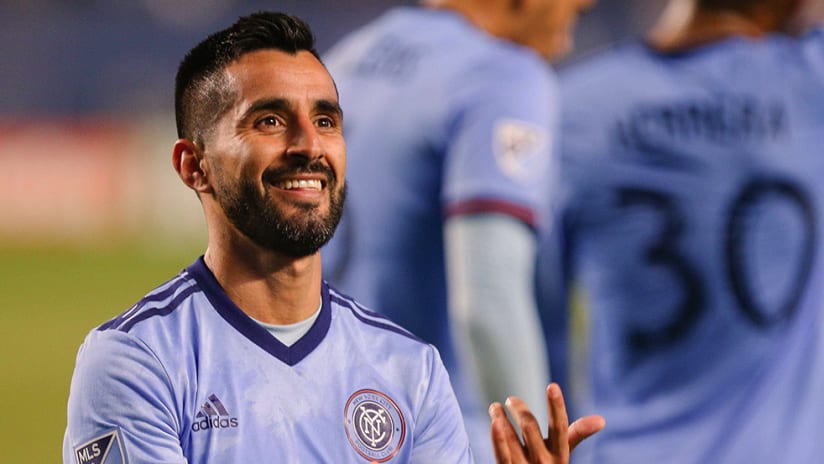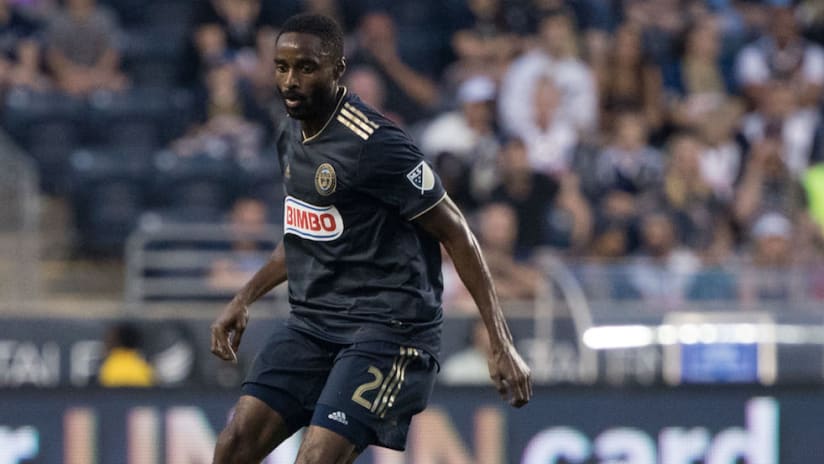Last Sunday, New York City FC beat the Philadelphia Union 3-1 at Yankee Stadium on Decision Day presented by AT&T. This Wednesday, the two will face off again at the same place, this time in a Knockout Round elimination game in the Audi 2018 MLS Cup Playoffs (7 pm ET | FS1, UniMás, TSN, TVAS).
With a home game, where they are 12-1-4 this season, against a team they just beat three days earlier, it's advantage NYC. Philadelphia weren’t run off the field, but they didn’t exactly get unlucky, either. NYCFC were the superior team and deserved to win. Philly need to reassess their approach.
TL/DR version: The Union should keep doing what they’ve been doing in attack, but adjust their defensive gameplan.
Philly created opportunities on Sunday. They shouldn’t veer away from their pass-and-move system. The situation doesn’t exactly suit them — Yankee Stadium has tight dimensions that often make it tough to possess, and NYC recently put down new sod that plays slower than most stadiums — but the Union have been building their attacking identity for two years now. It’s been the backbone of their success this season.
It wasn’t their ability on the ball that caused problems.
Rather, they had trouble in the defensive phase. Specifically, they need to fix their pressing scheme. Just about every time New York started possession in the back, they successfully moved the ball forward. If you try to press but fail, it leaves huge gaps in back.
Philly started their press as soon as NYCFC made the first pass out of the back. The Union used a man-to-man pressing system that basically said, “when you see an NYCFC player on the ball, go get pressure on him.” It’s the system I would use if I were coaching against New York.
- Yankee Stadium is tight, as mentioned, so it’s easier to get pressure on the ball. Plus...
- NYCFC’s players are good when they have time and space, so don’t give time or space.
I don’t think Philly should bail on the aggressive pressure. But they need to make adjustments.
The pressing rotation looked like this:
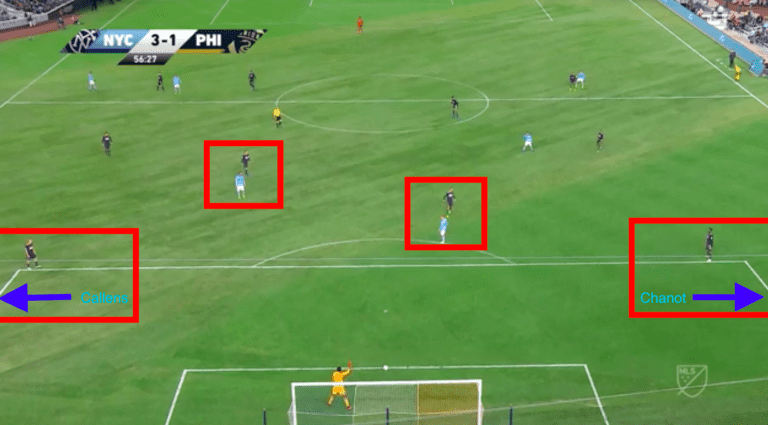
Philly’s center striker, either Cory Burke or CJ Sapong, always applied pressure to one center back. Borek Dockal would then step to the second center back. As Dockal moved forward, everyone behind him would step to the next player. Alejandro Bedoya would find Alex Ring, Haris Medunjanin would mark Yangel Herrera and Maxi Moralez, and the weak side midfielder would cover the free man.
Sometimes Dockal and Bedoya would stay and Fafa Picault, Sapong, or Ilsinho (second-half sub) would step to the center back from their wide position. When one of them applied the pressure, they would try to force the ball inside so the pass couldn’t reach the unmarked attacking outside back.
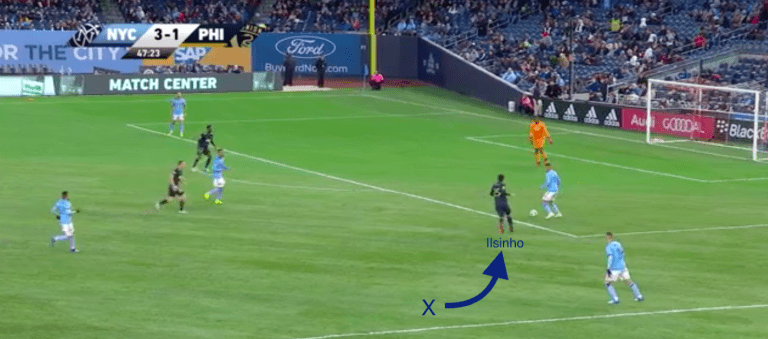
The Union’s plan failed in two ways.
First, NYC always had an extra man in midfield. As Dockal stepped toward a center back, the 3v3 in midfield turned into a 3v2 for New York. Philly would use the weak-sided midfielder to make up the difference, but he was left with a conundrum, too.
Here’s another look at the first picture. Out of the picture to the right is NYC’s right back, Anton Tinnerholm. If Picault had stayed central, NYC goalkeeper Sean Johnson would have played the easy outlet to Tinnerholm. If Picault goes to wide to Tinnerholm, then the player is wide open in the middle of the field.
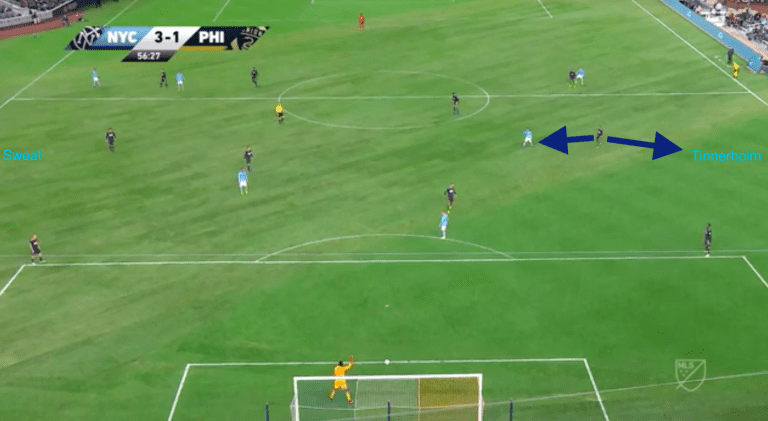
The Cityzens found Tinnerholm wide open a few times in the beginning of the game, so Picault started to shade that way, and then NYC found the player in the middle. There was always a free man.
Additionally, NYC’s Jesus Medina would tuck inside from his right wing position. Even when the Union had it 3v3 in midfield, Medina would come in to make it 4v3. It meant that the Union were always outnumbered and overrun in midfield. And NYCFC were always able to find that extra player because...
Philly never got tight enough to players or got enough pressure on the ball. Whenever they stepped to a man, they were always four or five feet away; four or five feet is too much space for Callens, Ring, Moralez and Herrera. Four feet doesn’t stress them. They could still pick up their heads and find a pass.
With these two things in mind, here are the two adjustments I would make:
1) Insert Derrick Jones or Warren Creavalle into the midfield.
Dockal and Medunjanin struggled to cover ground and close space; they need someone more athletic and with more energy. Bedoya is above average in both, but not to Jones’ or Creavalle’s level. Jones or Creavalle could cover more ground and limit NYC’s space and options throughout midfield. The auxiliary move would be to slide Bedoya to the right. Sapong or Burke would have to exit the lineup, but something needs to give to get more pressure on the ball in midfield. (Ed. note: Curtin said on Tuesday that Burke would start)
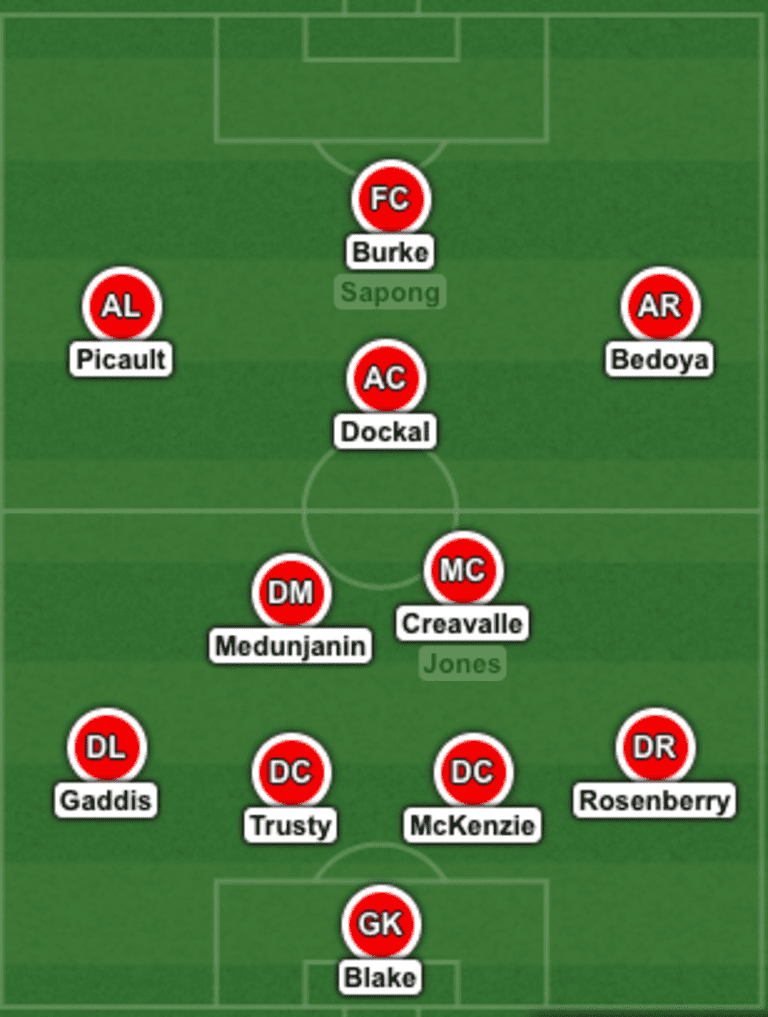
2) Demand the center backs take more risk in following players into the midfield.
NYC always had an extra guy somewhere in the middle of the field; conversely, Philly always had an extra man in their backline (Auston Trusty and Mark McKenzie vs. David Villa). One can understand why the Union would want to keep a numbers-up situation on Villa, but it didn’t work. Medina or Moralez would get time on the ball and play a pass that left the center back exposed anyway. So instead of waiting in line with Villa, Trusty or McKenzie need to step into the midfield and pick up the open player.
If we look at NYCFC’s third goal, that’s exactly what happened. Philly were 4v3 in the back, but still got roasted because Moralez had space in midfield.
We’ve talked all year about how great it’s been that the Union have been playing two Homegrown teenagers. Well, time to earn those big boy pants, guys. This is the type of game that really shows a center back’s quality. The toughest part of the position is the decisions. It’s not the tackles or the passing; it’s the decision to stay or go, to hold or step. Trusty and McKenzie played it too conservatively on Sunday, and understandably so, but head coach Jim Curtin needs to ask/let them to do more. If a team wants to press like Philly attempted on Sunday, they need their center backs to take risks.
There’s also a third option, but I’d be surprised to see them start with it. At the end of Sunday’s game, the Union played in a 3-5-2. Ray Gaddis moved to join Trusty and McKenzie at center back, while Fabinho slotted into left wingback and Ilsinho played right wingback. The 3-5-2 would naturally solve both issues: the two strikers could stick to NYC’s center backs, the midfielders could stay tight man-to-man in the middle and not have to cover ground to get tight, and the center backs would have more leniency to step into the midfield since they have the extra cover. But it’s a big leap to change formations for such a big game. I suspect Curtin keeps the same general 4-3-3 system but inserts new players to get different characteristics.
He needs to do something. The plan on Sunday didn’t work. NYC appear to be regaining form now that they have players healthy again. It won’t take big changes, just minor tweaks. But it’s getting those minor tweaks right that determines playoff games.

